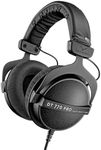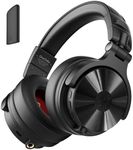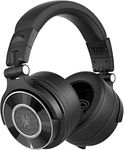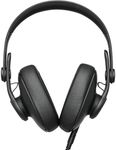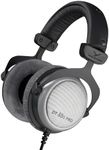Buying Guide for the Best Cheap Studio Headphones
When choosing studio headphones, it's important to focus on the features that will best suit your needs, whether you're mixing, recording, or simply enjoying music. Studio headphones are designed to provide a flat frequency response, which means they reproduce sound as accurately as possible without adding any coloration. This is crucial for critical listening tasks. Consider what you'll primarily be using the headphones for, as this will guide you in selecting the right specifications. Remember, the goal is to find a pair that offers the best sound quality and comfort for your specific use case.Frequency ResponseFrequency response refers to the range of sound frequencies that headphones can reproduce. It's important because it determines how well the headphones can handle different types of audio, from deep bass to high treble. A wider frequency response range means the headphones can reproduce more of the audio spectrum. Typically, studio headphones have a frequency response range of 20 Hz to 20 kHz, which covers the full range of human hearing. If you're working with bass-heavy music, you might want headphones that can go lower than 20 Hz. For general studio work, a standard range should suffice.
ImpedanceImpedance is a measure of electrical resistance and affects how much power the headphones need to deliver sound. It's important because it influences the compatibility with different audio sources. Low impedance headphones (under 50 ohms) are suitable for use with portable devices like smartphones and laptops, as they require less power. High impedance headphones (over 50 ohms) are better suited for professional studio equipment that can provide the necessary power. If you're using the headphones with a variety of devices, consider a mid-range impedance for versatility.
Driver SizeDriver size refers to the diameter of the speaker inside the headphones. It's important because larger drivers can produce more powerful and clearer sound, especially in the bass frequencies. Studio headphones typically have drivers ranging from 40mm to 50mm. If you prioritize bass and overall sound power, look for headphones with larger drivers. However, for balanced sound reproduction, the driver size should be considered alongside other factors like frequency response and design.
Closed-back vs. Open-backThis refers to the design of the headphone ear cups. Closed-back headphones have a sealed design that isolates sound, preventing it from leaking out or external noise from coming in. This is important for recording environments where sound isolation is crucial. Open-back headphones, on the other hand, allow air and sound to pass through the ear cups, providing a more natural and spacious sound. They are ideal for mixing and mastering where you want to hear a more accurate representation of the audio. Choose closed-back for recording and open-back for mixing, depending on your primary use.
Comfort and Build QualityComfort and build quality are crucial for long studio sessions. This includes the materials used for the ear pads and headband, as well as the overall weight of the headphones. It's important because uncomfortable headphones can lead to fatigue and affect your ability to work effectively. Look for headphones with adjustable headbands and cushioned ear pads for maximum comfort. Durable materials will ensure longevity, especially if you plan to use them frequently. Try them on if possible to ensure they fit well and feel comfortable over extended periods.

